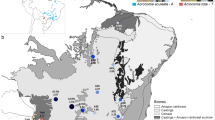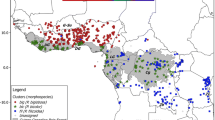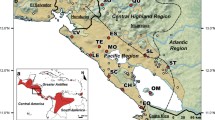Abstract
A previous phylogeography and genetic diversity study of Chamaedaphne calyculata (Ericaceae) showed that populations over its geographic range were strongly separated into two groups: a Eurasian/NW North American group and a NE North American one corresponding with the disjunct distribution of Sphagnum-dominated peatlands in north-western and central-eastern North America. Here, I have extended the survey and focused on the species’ detailed postglacial origin and the effect of isolation on genetic diversity patterns, particularly within island-like populations at the western periphery of its range in Europe. Using AFLP markers, estimates of genetic diversity within 16 C. calyculata populations in the Eurasian group were low (percentage of polymorphic loci P PL=14.9–24.8 %, Nei’s gene diversity H=0.060–0.119). Genetic diversity patterns within this species did not support the hypothesis that genetic diversity decreases towards the periphery of the range. Bayesian clustering analysis showed that population-level admixture was present in almost all studied 16 populations, suggesting multi-directional gene flow. On the other hand, the majority of assigned individuals (ca. 98 % of individuals) were offspring of the original residents, confirming that C. calyculata populations in the present day acted as discrete genetic units both in its continuous range and at its western periphery, and that gene flow was historic rather than contemporary in Eurasia. There was no correlation between genetic and geographic distance in the Eurasian group (r=0.02, P>0.05, Mantel test) nor at the western periphery (r=0.15, P>0.05, Mantel test). The isolation-by-distance (IBD) scatterplot matched Hutchinson and Templeton’s interpretation (case III), and geographic distance between populations was not a reliable predictor of the degree of genetic differentiation between populations. It is suggested that the lack of IBD might be a result of random genetic drift in rather disconnected populations that have become increasingly fragmented relatively recently. Positive and significant relationships between genetic and geographic distance on a small population scale was the result of biparental inbreeding of C. calyculata and restricted seed rain. Despite sporadic generative reproduction and limited dispersal, the fine-scale genetic structure within populations has been maintained, even though population sizes have been reduced to small fragments in recent years.






Similar content being viewed by others
References
Aldrich PR, Parker GR, Ward JS, Michler CH (2003) Spatial dispersion of trees in an old-growth temperate hardwood forest over 60 years of succession. Forest Ecol Managem 180:475–491
Baszyński T, Kłyszejko E, Sławiński W, Zawadzka I, Zawadzki K (1956a) The Gorbacz raised peatlands. Part I. Botanical and stratigraphic studies and chemical analysis of gytia. Acta Soc Bot Pol 25:421–433
Baszyński T, Kłyszejko E, Sławiński W, Zawadzka I, Zawadzki K (1956b) The Gorbacz raised peatlands. Part II. Chemical and biological analysis. Acta Soc Bot Pol 25:663–676
Bizoux JP, Mahy G (2007) Within-population genetic structure and clonal diversity of a threatened endemic metallophyte, Viola calaminaria (Violaceae). Amer J Bot 94:887–895
Bonin A, Bellemain E, Eidesen P, Pompanon F, Brochmann C, Taberlet P (2004) How to track and assess genotyping errors in population genetics studies. Molec Ecol 13:3261–3273
Damman AWH, French TW (1987) The ecology of peat bogs of the glaciated northeastern United States: a community profile. US Fish and Wildlife Service, Washington, DC
Dice LR (1945) Measures of the amount of ecologic association between species. Ecology 26:297–302
Doligez A, Baril C, Joly HI (1998) Fine-scale spatial genetic structure with nonuniform distribution of individuals. Genetics 148:905–919
Durka W (1999) Genetic diversity in peripheral and subcentral populations of Corrigiola litoralis L. (Illecebraceae). Heredity 83:476–84
Eckert CG, Samis KE, Lougheed SC (2008) Genetic variation across species’ geographic ranges: the central-marginal hypothesis and beyond. Molec Ecol 17:1170–1188
Eidesen PB, Alsos IG, Popp M, Stensrud Ø, Brochmann C (2007a) Nuclear versus plastid data: complex Pleistocene history of a circumpolar key species. Molec Ecol 16:3902–3925
Eidesen PB, Carlsen T, Molau U, Brochmann C (2007b) Repeatedly out of Beringia: Cassiope tetragona embraces the Arctic. J Biogeogr 34:1559–1574
Ellstrand NC, Elam DR (1993) Population genetic consequences of small population size: implications for plant conservation. Annual Rev Ecol Syst 24:217–242
Ehrich D (2006) AFLPdat: a collection of R functions for convenient handling of AFLP data. Molec Ecol Notes 6:603–604
Evanno G, Regnaut S, Goudet J (2005) Detecting the number of clusters of individuals using the software Structure: a simulation study. Molec Ecol 14:2611–2620
Excoffier L, Laval G, Schneider S (2005) Arlequin (version 3.2.2): an integrated software package for population genetics data analysis. Evol Bioinform Online 1:47–50
Falush D, Stephens M, Pritchard JK (2003) Inference of population structure using multilocus genotype data: linked loci and correlated allele frequencies. Genetics 164:1567–1587
Falush D, Stephens M, Pritchard JK (2007) Inference of population structure using multilocus genotype data: dominant markers and null alleles. Molec Ecol Notes 7:574–578
Flinn M, Wein A, Ross W (1977) Depth of underground plant organs and theoretical survival during fire. Canad J Bot 55:2550–2554
Flinn M, Wein A, Ross W (1988) Regrowth of forest understory species following seasonal burning. Canad J Bot 66:150–155
González-Martínez SC, Gerber S, Cervera MT (2002) Seed gene flow and fine-scale structure in a Mediterranean pine (Pinus pinaster Ait.) using nuclear microsatellite markers. Theor Appl Genet 104:1290–1297
Halsey LA, Vitt DH, Gignac LD (2000) Sphagnum-dominated peatlands in North America since the Last Glacial maximum: Their occurrence and extent. Bryologist 103:334–352
Hampe A, Petit RJ (2005) Conserving biodiversity under climate change: the rear edge matters. Ecol Lett 8:461–467
Hewitt GM (1996) Some genetic consequences of ice ages, and their role in divergence and speciation. Biol J Linn Soc 58:247–276
Hewitt GM (2000) The genetic legacy of the Quaternary ice ages. Nature 405:907–913
Heywood JS (1991) Spatial analysis of genetic variation in plant populations. Annual Rev Ecol Syst 22:335–355
Hoffmann AA, Hallas RJ, Dean JA, Schiffer M (2003) Low potential for climatic stress adaptation in a rainforest Drosophila species. Science 301:100–102
Holsinger KE, Lewis PO (2003) Hickory v. 1.0. Department of Ecology and Evolutionary Biology, University of Connecticut, Storrs. Available at http://www.eeb.uconn.edu/
Hutchinson DW, Templeton AR (1999) Correlation of pairwise genetic and geographic distance measures: inferring the relative influences of gene flow and drift on the distribution of genetic variability. Evolution 53:1898–1914
Ilnicki P (2002) Peat-bogs and peat. University of Life Sciences in Poznań, Poznań
Jacquemyn H, Brys R, Honnay O, Hermy M, Roldán-Ruiz I (2005) Local forest environment largely affects belowground growth, clonal diversity and fine scale spatial genetic structure in the temperate deciduous forest herb Paris quadrifolia. Molec Ecol 14:4479–4488
Jones FA, Hamrick JL, Peterson CJ, Squiers ER (2006) Inferring colonization history from analyses of spatial genetic structure within populations of Pinus strobus and Quercus rubra. Molec Ecol 15:851–861
Jump AS, Peńuelas J (2006) Genetic effects of chronic habitat fragmentation in a wind-pollinated tree. Proc Natl Acad Sci USA 103:8096–8100
Kaźmierczakowa R, Zarzycki K (2001) Polska Czerwona Księga Roślin (Polish Red Data Book of Plants). Instytut Botaniki im. Władysława Szafera, PAN, Kraków
Kevan PG, Tikhmenev EA, Usui M (1993) Insects and plants in the pollination ecology of the boreal zone. Ecol Res 8:247–267
Klimko M, Kosińska E, Szkudlarz P (2000) Morphometry of the leaves of Chamaedaphne calyculata (L.) Moench. Roczn Akad Roln Poznaniu 3:143–154
Kloss M (1996) Plant succession on Chamaedaphne calyculata (L.) Moench mire in the Kampinos Forest. Polish Ecol Stud 22:129–139
Kovach WL (1999) M vsp – A Multivariate Statistical Package for Windows ver. 3.1. Kovach Computing Service, Pentraeth, Wales
Kruszelnicki J (2001) Chamaedaphne calyculata. In Kaźmierczakowa R, Zarzycki K (eds) Polish Red Data Book of Plants. Instytut Botaniki im. Władysława Szafera, PAN, Kraków, pp 283–285
Latałowa M (1999) Analiza paleoekologiczna obiektu “Sicienko” (The paleoecological analysis of “Sicienko”). In Herbich J, Herbichowa M, Latałowa M (eds) Plan ochrony ekosystemów torfowiskowych Drawieńskiego Parku Narodowego (The conservation plan of peat bogs in the Drawa National Park). Stowarzyszenie Pracowni Autorskich Afix dla Drawieńskiego Parku Narodowego, Poznań, p 44
Lauterbach D, Ristow M, Gemeinholzer B (2011) Genetic population structure, fitness variation and the importance of population history in remnant populations of the endangered plant Silene chlorantha (Willd.) Ehrh. (Caryophyllaceae). Pl Biol 13:1–11
Lewandowska-Sabat AM, Fjellheim S, Rognli OA (2010) Extremely low genetic variability and highly structured local populations of Arabidopsis thaliana at higher latitudes. Molec Ecol 19:4753–4764
Mahy G, Ennos RA, Jacquemart AL (1999) Allozyme variation and genetic structure of Calluna vulgaris (heather) populations in Scotland: the effect of postglacial recolonization. Heredity 82:654–660
Malinowska H, Janyszek M, Szczepaniak M (2004) Propagation of leather leaf Chamaedaphne calyculata Moench from seeds and shoot cuttings. Dendrobiology 52:33–37
McDonald RI, Peet RK, Urban DL (2003) Spatial patterns of Quercus regeneration limitation and Acer rubrum invasion in a Piedmont forest. J Veg Sci 14:441–450
Meusel H, Jäger E, Rauschert S, Weinert E (1978) Vergleichende Chorologie der zentraleuropäischen Flora. Fischer, Jena
Mirek Z, Zarzycki K, Wojewoda W, Szeląg Z (2006) Red List of Plants and Fungi in Poland. Instytut Botaniki PAN, Kraków
Morgante M, Vendramin GG, Rossi P (1991) Effects of stand density on outcrossing rate in two Norway spruce (Picea abies) populations. Canad J Bot 69:2704–2708
Murawski IA, Hamrick JL (1991) The effect of the density of flowering individuals on the mating system of nine tropical tree species. Heredity 67:167–174
Nei M, Li WH (1979) Mathematical model for studying genetic variation in terms of restriction endonucleases. Proc Natl Acad Sci USA 76:5269–5273
Parker KC, Hamrick JL Parker AJ, Nason JD (2001) Fine-scale genetic structure in Pinus clausa (Pinaceae) populations: effects of disturbance history. Heredity 87:99–113
Peakall R, Smouse P (2005) Genalex 6: genetic analysis in Excel. Population genetic software for teaching and research. Molec Ecol Notes 6:288–295
Pellini SL, Dzurisin JDK, Prior KM, Williams CM, Marsico TD, Sinclair BJ, Hellman JJ (2009) Translocation experiments with butterflies reveal limits to enhancement of poleward populations under climate change. Proc Natl Acad Sci USA 106:11160–11165
Petit RJ, Bialozyt R, Garnier-Géré P, Hampe A (2004) Ecology and genetics of tree invasions: from recent introductions to Quaternary migrations. Forest Ecol Managem 197:117–137
Pérez-Collazos E, Sanchez-Gómez P, Jiménez JF, Catalán P (2009) The phylogeographical history of the Iberian steppe plant Ferula loscosii (Apiaceae): a test of the abundant-centre hypothesis. Molec Ecol 18:848–861
Premoli AC, Kitzberger T (2005) Regeneration mode affects spatial genetic structure of Nothofagus dombeyi forests in northwestern Patagonia. Molec Ecol 14:2319–2329
Pritchard JK, Stephens M, Donnelly P (2000) Inference of population structure using multilocus genotype data. Genetics 155:945–959
Reader RJ (1977) Bog ericad flowers: self-compatibility and relative attractiveness to bees. Canad J Bot 55:2279–2287
Rohlf FJ (1997) NTSYS-pc numerical taxonomy and multivariate analysis system, ver. 2.0. Exeter Publications, New York
Sexton JP, McIntyre PJ, Angert AL, Rice KJ (2009) Evolution and ecology of species range limits. Annual Rev Ecol Evol Syst 40:415–436
Small E (1976) Insect pollinator of the Met Bleue peat bog of Ottawa. Canad Field-Naturalist 90:22–28
StatSoft, Inc. (1997) Statistica for Windows. Computer program manual. Available at: http://www.statsoft.com
Szczecińska M, Sawicki J, Wąsowicz K, Hołdyński C (2009) Genetic variation of the relict and endangered population of Chamaedaphne calyculata (Ericaceae) in Poland. Dendrobiology 62:23–33
Tylżanowski T (1975) Chamedafne północna – Chamaedaphne calyculata w Borach Tucholskich (The Leatherleaf – Chamaedaphne calyculata in Bory Tucholskie Forest). Chrońmy Przyr Ojczysta 31:51–52
Vekemans X (2002) A flp -S urv version 1.0. Université Libre de Bruxelles, Belgium
Vekemans X, Hardy OJ (2004) New insights from fine-scale spatial genetic structure analyses in plant populations. Molec Ecol 13:921–935
Vos P, Hogers R, Bleeker M, Reijans M, van de Lee T, Hornes M, Frijters A, Pot J, Peleman J, Kuiper M, Zabeau M (1995) AFLP: a new technique for DNA fingerprinting. Nucleic Acids Res 23:4407–4414
Wells GP, Young AG (2002) Effects of seed dispersal on spatial genetic structure in populations of Rutidosis leptorrhynchoides with different levels of correlated paternity. Genet Res 79:219–226
Williams DA, Muchugu E, Overholt WA, Cuda JP (2007) Colonization patterns of the invasive Brazilian peppertree, Schinus terebinthifolius, in Florida. Heredity 98:284–293
Wróblewska A (2012) The role of disjunction and post-glacial population expansion on phylogeographic history and genetic diversity of circumboreal plant, Chamaedaphne calyculata. Bot J Linn Soc 105:761–775
Acknowledgements
I thank Alexander Batalov, Peter Efimov, Edyta Jermakowicz, Anna Otręba, Martti Salo, Vladimir Semerikov, Oleg Sozinov, Monika Szczecińska, Kadri Tali, Izabela Tałałaj, Irina Tatarenko, Gergely Várkonyi, Anna Wedel-Sala, Dan Wołkowycki and Hanna Zacharczuk for help with collecting samples in Poland, and Beata Ostrowiecka for technical assistance in the laboratory. Michael Jacobs helped edit the manuscript and Andreas Tribsch, as well as three anonymous referees, gave insightful comments on an earlier version of the manuscript. This research was funded by a grant from the Polish Ministry of Science and Higher Education (NN303 366135).
Author information
Authors and Affiliations
Corresponding author
Electronic Supplementary Materials
Below is the link to the electronic supplementary material.
ESM 1
(PDF 7 kb)
Rights and permissions
About this article
Cite this article
Wróblewska, A. Genetic Diversity and Spatial Genetic Structure of Chamaedaphne calyculata (Ericaceae) at the Western Periphery in Relation to its Main Continuous Range in Eurasia. Folia Geobot 49, 193–208 (2014). https://doi.org/10.1007/s12224-013-9165-1
Received:
Revised:
Accepted:
Published:
Issue Date:
DOI: https://doi.org/10.1007/s12224-013-9165-1




